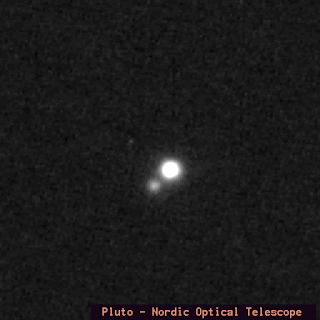Pluto is believed to have a rocky core surrounded by a mantle of ice. Its surface is covered with a bright layer of frozen methane, nitrogen, and carbon monoxide. During its highly elliptical orbit, when it reaches its closest point to the Sun, these ices melt, rise, and temporarily form a thin atmosphere and when it is traveling away from the Sun the bulk of the planet's atmosphere freezes.
Discovery and Naming of Pluto
Pluto was discovered by the astronomer Clyde Tombaugh at the Lowell Observatory in Arizona on February 18, 1930.
| Pluto |
Tombaugh urged the director of Lowell Observatory, Vesto Melvin Slipher, to suggest a name for the new planet before someone else did. People from around the world started sending in their suggestions. Names like Zeus Artemis, Athene, Atlas, Cosmos, Hera, Hercules, Icarus, Idana, Odin, Pax, Persephone, Perseus, Prometheus, Tantalus, Vulcan, Zymal etc received maximum support. The problem facing the astronomers was that a majority of the mythological names had already been allotted to the numerous asteroids, all female names had been taken up by other bodies and male names were only allotted to objects which had unusual orbits.
| Pluto & Charon |
The name Pluto was suggested by an eleven-year-old girl from Oxford, Venetia Burney. Her grandfather asked what she thought would be good name for the newly discovered planet. Venetia suggested that as the planet had severely cold conditions and was distant it should be named after the Roman God of the underworld

No comments:
Post a Comment